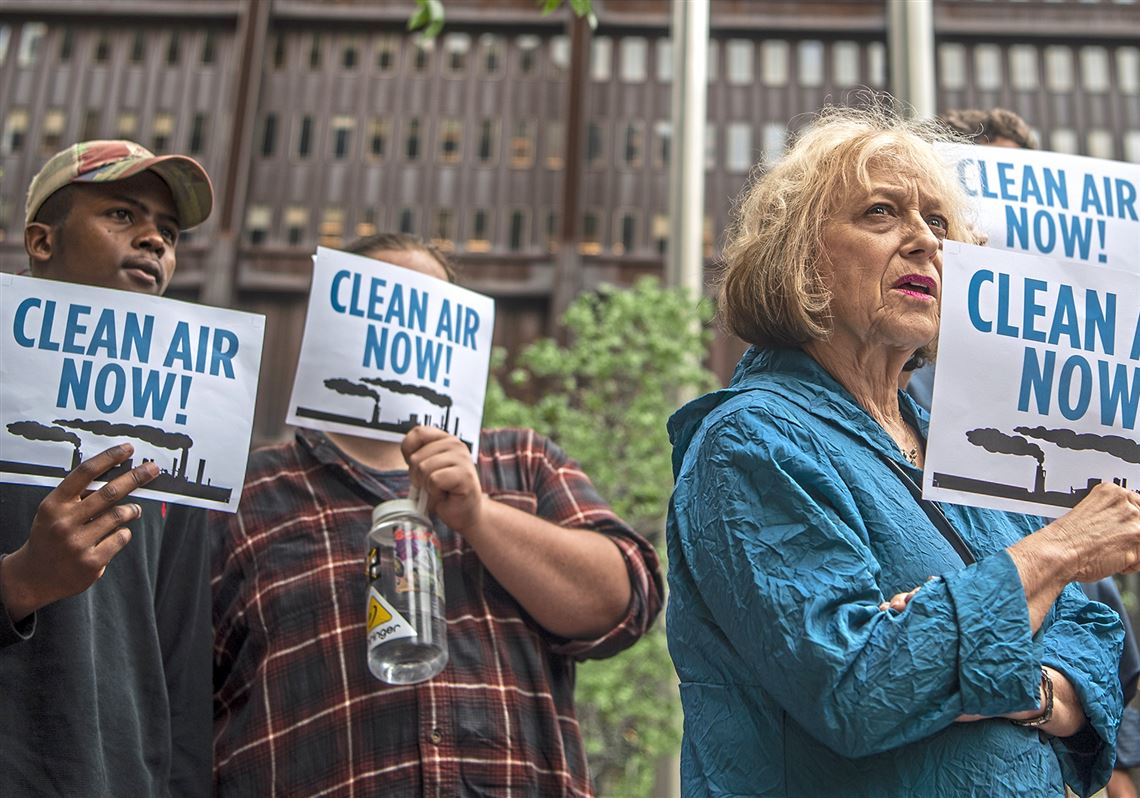Residents of Clairton, Pittsburgh’s East End neighborhoods and environmental organizations gathered outside U.S. Steel Corp.’s Downtown headquarters Thursday afternoon to demand the company spend the money needed to fix its Mon Valley coke works where two fires in six months made pollution control equipment inoperable.
“We’re here to express our frustration and demand change,” Dave Smith, a Clean Air Council spokesman, said to about 30 people gathered on the sidewalk along Grant Street. “We want accountability from the Clairton Coke Works, and we want U.S. Steel to take responsibility for the pollution it puts out.”
He said Clairton has been a long-term and ongoing pollution problem and the organizations and residents will continue to rally, protest and demonstrate against its operation. He urged the public to contact state legislators and city and county officials and to demand that the pollution stop.
Rachel Filippini, executive director of the Group Against Smog and Pollution, said the steelmaker should commission an independent audit to identify operational deficiencies at the 118-year-old coke-making facility, located 20 miles south of Pittsburgh along the Monongahela River.
“Such an independent audit would assure that deficiencies at the plant are identified, appropriate remediation efforts undertaken and future incidents and fires that have the potential to adversely affect local air quality, averted,” Ms. Filippini said.
A massive fire at the Clairton coking facility on Dec. 24 severely damaged its desulfurization equipment, a major air pollution control system that removes sulphur from coke oven gases. During the next three and a half months while the equipment was repaired, the coke works continued to operate and exceeded its sulfur dioxide, hydrogen sulfide and soot limits on 28 days.
A second, much smaller electrical fire on Monday knocked the desulfurization equipment out of operation again, this time for approximately 15 hours.
Between the two fires, U.S. Steel announced it would invest $1 billion to upgrade its Mon Valley Works steel plants — Edgar Thomson in Braddock and Irvin in West Mifflin — but spending at Clairton was limited to construction of a new cogeneration plant that will convert a portion of the coke oven gases into electricity to power the steel mills.
The company said the cogen plant will reduce emissions of soot by 60%, sulfur dioxide by 50% and nitrogen oxides by 80%, but Geoff Bland, representing Clean Water Action, said those projected reductions are unproven.
“U.S. Steel will spend a small fraction of its investment in the Mon Valley Works in Clairton,” he said, “and I’m not sure it will affect any of the emissions levels at all.”
Ruth Fauman-Fichman, a Squirrel Hill resident and research associate at the University of Pittsburgh, called the pollution emitted by the coke works a “stain” on Pittsburgh’s most livable title.
“To make Pittsburgh worthy of its most livable title, U.S. Steel must focus on reducing the pollutants, or shut down,” she said.
Amanda Malkowski, a U.S. Steel spokeswoman, issued a statement detailing the company’s investments of money and manpower at the Clairton works, and said that paid off in lower levels of soot emissions.
“U. S. Steel is absolutely committed to making even more substantial investments in Clairton to make further environmental improvements and we have been working with the [Allegheny County Health Department] for its input and assistance before implementation,” according to the statement.
The email noted that the small fire caused no public health risk and said, “Protecting our shared environment remains a top priority for U. S. Steel ... .”
The Allegheny County Health Department has levied fines totaling more than $2.4 million in the last year for violations at the coke works, but U.S. Steel has appealed those penalties. The company paid fines totaling more than $4 million under enforcement actions issued against the Clairton facility in 2007, 2008, 2010, 2011, 2014 and 2016.
The health department has also joined two environmental organizations in a federal lawsuit alleging the company illegally operated all three of its Mon Valley facilities — the coke works and the two mills — after the Dec. 24 fire.
Clairton’s 10 coke batteries contain 708 coke ovens and more than 6,300 potential coke gas emission points. Each year, the facility produces about 4.3 million tons of coke.
Don Hopey: dhopey@post-gazette.com or 412-263-1983. Twitter: @donhopey.
First Published: June 20, 2019, 9:00 p.m.
















